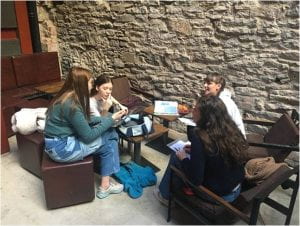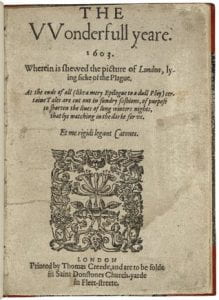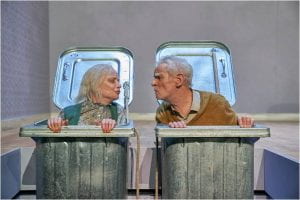Being a first-year Theatre Student during lockdown brings with it very particular limitations. The experience of live theatre either as a member of the audience or as part of the production is not possible. Maybe this is what a chef feels like without a kitchen; a footballer without a team, and a student of literature without books. Four of our fabulous first years here in the Department of Theatre, have put pen to paper, or rather finger to keyboard, to try and figure out what it is we’re missing when watching theatre on screen in lockdown.
Georgia Casimir: Frankenstein, National Theatre
I watched the recording of the National Theatre’s production of Frankenstein, starring Benedict Cumberbatch as the Creature, and Jonny Lee Miller as Victor Frankenstein. I loved the performance – the huge theatre space (and presumably equally huge budget) allowed for some really amazing effects: thousands of light bulbs were suspended above the stage and audience and created moments of gentle, romantic starlight and equally harsh, exposing and clinical light; there were moments of mechanical music accompanied by chanting, and a 10-minute opening sequence where Cumberbatch broke out of his embryonic cell and essentially spent the next few minutes learning how to walk.
The thing is, as amazing as it was to watch, it mostly felt amazing because I was imagining how it would feel to be an audience member. Watching the performance on a screen, in my own bedroom, it was hard to experience that sense of immediacy that the audience was definitely experiencing. I imagine it would have been a genuinely frightening performance – it is hard to watch a fully grown man struggle so much with basic speech and coordination, accompanied by his grotesque appearance and erratic behaviours, I would have been scared he was going to crawl up into the audience.
Therefore, as much as I was genuinely enthralled by the production, I certainly still felt somewhat left out, experiencing only about 70% of the sensations that I would have had I been there in the flesh. That being said, there are definitely some benefits to watching a recording of a performance.
For starters, you can see everything. The stage was vast, and I doubt whether even the front-row audience member would have been able to see Cumberbatch’s incredible stage makeup in the same detail as I did. Additionally, some of the slower, more dialogue-heavy scenes were somewhat filmic and definitely lent themselves well to a performance.
I can absolutely see the benefits of watching recorded performances. It is generally cheaper, more accessible and allows for the close-up viewing that is hard to achieve from an auditorium; however, on the whole I would still much prefer to see a performance in the flesh – the uncertainty of theatre, the knowledge that there is only one shot at a performance on any one night, and the overall more immediate experience certainly warrants travelling out of my way to watch it myself.
Jasper Price: Hamlet (2016), Royal Shakespeare Company
I watched the latest Royal Shakespeare Company production of Hamlet from the comfort of my living room. I didn’t have to traipse the two-hour journey to London’s Hackney Empire to watch this play. No traffic, no horrible train journey, no sweltering tube ride. I walked from my bedroom to the living room; about 10 feet and didn’t encounter a single person. I didn’t have to wait in a massive queue to use the lavatory as you do at the theatre.
When I sat down, my legs were not wedged in a vice-grip hold, devoid of circulation. Instead, I sat on my sofa and put my legs up on the coffee table. I was able to eat what I liked without the fear of being shushed by another theatregoer. So far this virtual theatre trip is proving easier than the real thing.
However, as the play began, I suddenly felt distanced, unattached from the performance. The lights had gone down in the theatre but sunlight was still streaming from my window. I did not feel totally engaged with the production, as being there would have assured; and my cat miaowing during “to be or not to be” killed any theatrical atmosphere that I was feeling.
Atmosphere. That is the key word to any live event; you and the rest of the audience united for a brief few hours, engaged together in the majesty of live performance. That feeling you get when the lights go down, and everyone falls silent together, is lost at home. Another huge negative with watching a theatre production is that we see what the director wants us to see. As a theatre student, I look away from the main action to see what else is happening onstage; the other actors, the lighting, the set etc. However, I am forced to look watch only the lead actors through a series of closeups.
However, the greatest reason for watching the play virtually was that I didn’t have to watch the whole thing. I spread the play out over multiple days because I was not prepared to sit for three and a half hours watching Hamlet. I would have in the theatre but at home? No. There are pros and cons to watching performance at home, but to me, an 11-inch laptop screen will never beat an 11-metre stage.
Isobel Edmondson: Twelfth Night, National Theatre
Despite not knowing the story of Shakespeare’s Twelfth Night at all, I found it enjoyable and laughed out loud at some parts, because the themes and characters were so clearly conveyed in the physicality, gestures and voice of the actors. The character Malvolio was changed to a female Malvolia, which I did not really see the point of. While I try to keep an open mind and tell myself that gender does not matter, it clearly does, and it potentially changes the way the audience see the events in the play. Maybe if I knew the play better, I would see why this decision was made, or perhaps I’d be even more confused.
Nevertheless, Tamsin Greig was amusing as Malvolia and I enjoyed her use of gesture, for example: she repeated a hand movement every time she repeated a certain phrase. The phrase itself was not even particularly funny as far as I can remember, but she made it comical with that simple action. A revolving stage was used to transition between scenes which I thought was much more aesthetically pleasing than a blackout or a curtain might have been. It was slick and even added comedy in some parts. I always appreciate the National Theatre’s creative use of space and set design.
In general, watching stage on screen is something I did before quarantine in the cinema so it has not been such an adjustment for me. Of course, there are some differences though, especially when watching it at home, for example: you are not sitting in the audience. This made me feel somewhat detached from the play, as the audience’s reaction can affect the way you experience a performance. There is a sense of community and camaraderie when watching something with a lot of other people, in the same way that a large part of the atmosphere at a concert is dependent on the audience’s presence. There is also the fact that the action is not live, which means that camera angles could have been edited and manipulated in a certain way.
This forces the audience’s attention on one particular area, which means that everyone watching has a pretty similar or near identical experience compared to the audience members who were actually there; could have looked anywhere and had different perspectives based on where they were sitting. This could be seen as a positive thing, however, as the close-up view of the action allows you to notice smaller and more subtle facial expressions and interactions of the characters, almost like a film. In that regard, the best seats in the house are at home. Either way, I think if I were a fan of a particular actor or if they were just well-known, it’d be much more exciting seeing them in the flesh than on my screen. It would just feel more special and rare. I could tell my grandchildren that I saw them and maybe they’d be impressed and envious that we were actually in the same room.
By Georgia Casimir, Isabel Edmondson, Jasper Price, and Dr Katja Krebs.









